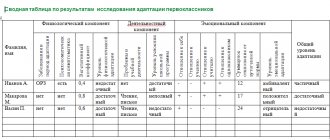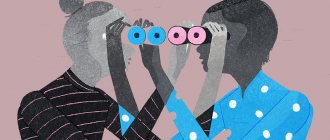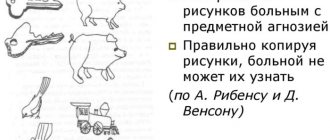In order for a sensation to arise as a result of the action of a stimulus on the sense organs, it is necessary that the stimulus causing it reaches a certain value or threshold of sensitivity. There are two types of sensitivity thresholds: absolute and differential (or discrimination sensitivity threshold).
The lowest strength of the stimulus at which a barely noticeable sensation occurs is called the lower absolute threshold of sensation .
The lower threshold of sensations is opposed by the upper threshold. The greatest strength of the stimulus, at which a sensation of this type still occurs, is called the upper absolute threshold of sensation . The upper threshold limits sensitivity on the greater side, and up to a certain limit, above which pain occurs or there is no change in the intensity of sensations.
Thresholds of sensations are individual for each person and change throughout his life. Sensations, in addition to the magnitude of the absolute threshold, are also characterized by a threshold for discrimination, which is called the differential threshold.
Differential threshold is the smallest value of differences between stimuli when the difference between them is still perceived. The differential threshold of sensations for different sense organs is different, but for the same analyzer it is a constant value.
The Bouguer-Weber law states: the differential threshold of sensation is different for different sense organs, but for the same analyzer it is a constant value. The constant itself is called the Weber constant.
The values of the Weber constant for various senses are given in the table:
| Feel | Constant value |
| Changing pitch | 0,003 |
| Changing the brightness of the light | 0,017 |
| Change in pressure on the surface of the skin | 0,140 |
| Changing the weight of an item | 0,020 |
| Changing the sound volume | 0,100 |
Lower and upper absolute thresholds of sensation (absolute sensitivity) and differential thresholds of discrimination (relative sensitivity) characterize the limits of human sensitivity .
Along with this, operational thresholds of sensations - the magnitude of the signal at which the accuracy and speed of its discrimination reaches a maximum. This value is an order of magnitude larger than the discrimination threshold and is used in various practical calculations.
Pathological changes in sensitivity thresholds include a decrease in sensitivity thresholds - hyperesthesia, an increase - hypoesthesia, complete loss - anesthesia and perversion - senesthopathy, psychotic states (acute hallucinosis, paranoid, etc.), initial manifestations of non-paroxysmal clouding of consciousness (delirium, oneiroid, amentia).
Hyposthesia is a decrease in susceptibility to external stimuli, when the surrounding world, individual objects and properties lose their brightness, colorfulness, richness, and distinct individuality. Occurs in cases of stupor, depressive states, hysterical syndromes, alcohol and drug intoxication.
Hyperalgesia is an increase in pain sensitivity, observed in various pathological conditions, in particular with depression, especially masked depression (“algic melancholia” (Petrilovich, 1970)).
Anesthesia is manifested by anatomical and functional damage to the analyzer, starting from the receptor section and ending with the cortical representation, which is clinically accompanied by loss of skin sensitivity, loss of taste, smell, blindness, and deafness.
In neurology, visual agnosia (failure to recognize visual images, letters, words), auditory (failure to recognize objects when palpating), autotopoagnosia (failure to recognize parts of one’s body), anosognosia (failure to recognize illness, injury), and facial agnosia are distinguished. In hysterical neurotic syndromes, mental amblyopia (blindness), mental anosmia (insensitivity to smells), mental ageusia (loss of the sense of taste), mental deafness, mental tactile and pain anesthesia (analgesia) are observed.
Attention. Pathology of attention
Attention is the direction and concentration of consciousness.
Properties of attention:
1. Stability – the duration of maintaining intense attention.
2. Switching attention is a deliberate transition from one object to another.
3. Distribution of attention - simultaneously successfully performing two or more types of activities.
4. Volume of attention – the number of objects of attention simultaneously held in consciousness.
Types of attention:
- voluntary (the highest type of attention is active attention)
- involuntary (determined by the psychophysiological characteristics of a person and the qualitative characteristics of the stimulus).
Theories of attention:
— Motor theory ( R. Descartes ). Since the state of attention can be caused by volitional effort, Descartes suggested that such effort must be exclusively muscular
— Attention as a result of limited consciousness. ( Herbert and Hamilton ). They noticed that if one of the ideas is most intense, then all others are repressed from consciousness. A person focused on a certain thought or perception does not hear or notice anything extraneous in relation to the object of attention and turns out to be, as it were, “blind” and “deaf” to the entire world around him.
— Activation theory ( Lindsley ). Human behavior is determined by fluctuations in arousal. The lower limit is sleep, the upper limit is hyperexcitation. Between sleep and states of extreme arousal, there are a number of levels that make up the range of intensity of behavior. A certain segment of this range corresponds to the highest performance, which represents attention.
— The principle of dominance ( A.A. Ukhtomsky ). The excitatory process can create a temporary focus of excitation that summarizes and accumulates impulses flowing into the central nervous system, while simultaneously suppressing the activity of other centers.
Attention is the ability to concentrate on any external or internal events, objects or activities. Attention contributes to a sustainable increase in the level of sensory, intellectual and motor activity, ensuring the productivity of mental activity. Attention does not have its own, separate and specific product. Its result is the improvement of any mental activity to which it is connected.
There are active (voluntary) and passive (involuntary), post-voluntary attention. Among the properties of attention are stability, volume, switchability, and direction.
Attention disorders include:
- absentmindedness - impaired ability to maintain focus for a long time;
- exhaustion - weakening of the intensity of attention, rapid transition of active attention to passive;
- distractibility - increased mobility, rapid changes in direction, concentration, intensity of attention;
- stiffness - inertia, fixed attention, with difficulty switching from one object to another;
- narrowing of the scope of attention is a pathological concentration caused by the weakness of its distribution between objects.
Attention disorders are part of all positive and negative syndromes.
Physiological mechanisms and patterns of sensations
In the process of the emergence of sensations, two parties are involved: the irritant that affects the body, and the analyzers that perceive this irritation. Sensation is not a passive reflection, but an active process during which all parts of the analyzer work together.
The analyzer is a part of the nervous system that has the ability to distinguish between the effects of external stimuli. It consists of three parts :
- Receptors are nerve endings located in the sense organs, which are characterized by a lower threshold of irritability with increased sensitivity to the stimuli themselves. This allows the receptors to respond to even the smallest impacts and reflect the excessive impact of the stimulus on the body. There are two types of receptors: exteroceptors (process information coming from the outside world) and interoceptors (process information coming from the body itself).
- The central part is the areas of the brain that are able to distinguish the corresponding stimulus (for example, visual) and convert its effect into sensation itself.
- Conducting pathways - transmit excitation of sensory organs and receptors to the central part of the analyzer.
Briefly, the stages of operation of analyzer systems can be demonstrated as follows :
- The influence of an external stimulus on the receptor of the analyzing system.
- Transmission of a stimulus along a reflex arc.
- A stimulus enters an area in the cerebral cortex corresponding to a specific receptor.
- The reaction of the psyche (or analytical system) to a stimulus.
Sensations are also subject to general psychophysiological laws. These include sensory thresholds, adaptation, synesthesia and sensitization.
Thresholds of sensations
A sensation can only occur if the stimulus has a certain magnitude. If this value is less or more than the norm, then the person will not feel anything (for example, we are not able to feel dust particles on our clothes or hear ultra-high frequencies). To denote this value in psychophysics, the concept of “sensitivity thresholds” is used.
The lower absolute threshold is what the minimum value of the stimulus must be in order to cause at least the weakest sensation. The ability to respond to the weakest stimuli is called absolute sensitivity.
The upper absolute threshold is the magnitude of the stimulus at which the sensation turns into pain or disappears altogether.
The absolute threshold and sensitivity of the analyzer are characterized by an inversely proportional relationship to each other: the higher the sensitivity, the lower the threshold value (for example, a person with a developed sense of smell will need a much less intense aroma of coffee or a shorter distance to smell it than someone with this receptor is not developed).
Human analyzers have varying degrees of sensitivity due to the fact that the senses are continuously developing in the process of individual human development. They are influenced by many factors, the main of which are the individual’s professional background and his interests. Thus, a sommelier can distinguish the most subtle notes of wine, while other people will not even feel them. In addition, a person’s age and health also affect the degree of sensitivity of analyzers and the value of individual thresholds: in the presence of diseases and with age, the degree of sensitivity of analyzers decreases.
Adaptation
Sense organs can adapt to a stimulus by changing the sensitivity of their analyzers by increasing or decreasing it to varying degrees.
This ability is called adaptation and has three degrees :
- Change in sensitivity (if the stimulus is weak). So, when we enter a dark room, at first it is difficult for us to see something, but gradually the sensitivity of the analyzer increases, and we begin to distinguish objects. And if we then go into another – lighter – sensitivity of the analyzer decreases again.
- Dullness of sensation (if the stimulus is too strong). This can be seen, for example, when immersing your hand in cold water.
- Complete disappearance of sensation (if the stimulus acts for too long).
The greatest range of adaptation is typical for the visual analyzer, then for the skin analyzer, while the auditory analyzer has practically no ability to adapt (you can get used to noise, but you cannot stop hearing it). As for speed, the olfactory and tactile analyzers adapt faster than others.
Synesthesia
Sometimes a person may experience “phantom” sensations that are not characteristic of the analyzer under the influence of which they appear. For example, the sight of a lemon can make you feel a sour taste in your mouth, and visual images can arise under the influence of sounds.
Sensitization
Sensitization is an increase in the sensitivity of the analyzer under the influence of internal (mental) factors.
A number of reasons why sensitization may occur:
- The significance of a particular impact. For example, our hearing becomes sharper if we really want to hear a sound and “listen” to the lyrics of a song or someone's conversation.
- Physiological factors. The state of the body and the presence of certain substances in it can also lead to a change in the sensitivity of a particular analyzer. For example, introducing vitamin A into the body can increase visual sensitivity.
- Interconnection of analyzers. The work of analyzers is systemic, therefore, for example, visual sensitivity is affected by temperature changes, taste sensations and sounds.
- Training. Repeated exercise also helps increase the sensitivity of the analyzers. For example, playing music can lead to the development of acute hearing. We will talk more about this method of sensitization at the end of our article to show you how you can develop your sensations.
Also interesting is the phenomenon called “compensatory sensitization,” in which the sensitivity of the analyzer increases due to insufficient sensitivity in another analyzer. For example, blind people often experience an increase in auditory sensitivity, which allows them to achieve unprecedented success, for example, in musical activity.
We are sure that this knowledge has helped you to understand in general terms the nature of sensations. And now we will talk about why a person needs sensations in general.
Imagination and representation.
Imagination and representation are tools for reflecting and designing the world around us.
Imagination is a mental cognitive process of creating new ideas based on existing experience, that is, a process of transformative projection of reality.
Imagination is a reflection of external space in new unusual combinations and connections. It occupies an intermediate position between perception and thinking, thinking and memory. This is one of the most mysterious psychic phenomena. We know almost nothing about the mechanism of imagination, its anatomical and physiological basis.
Imagination is unique to humans. It allows him to go beyond the real world in time and space, giving him the opportunity to imagine the finished result of his work even before starting work. Almost all human material and spiritual culture is a product of people's imagination and creativity.
Involuntary imagination is also called passive or unintentional imagination - this is the creation of new images without any external stimuli. It consists in the emergence and combination of ideas and their elements into new ideas without a specific intention on the part of a person, with a weakening of conscious control on his part over the course of his ideas.
It appears most clearly in dreams or in a half-asleep, drowsy state, when ideas arise spontaneously, replace, combine and change on their own, sometimes taking on the most fantastic forms.
Voluntary imagination , or, as it is also called, active or deliberate imagination, is the creation of new images through volitional efforts. It represents the deliberate construction of images in connection with a consciously set task in one or another type of activity.
Representation is the process of mentally recreating images of objects and phenomena that currently do not affect the human senses.
In accordance with the division of views by types of the leading analyzer, the following types of views are distinguished:
— visual (image of a person, place, landscape);
- auditory (reproduction of a musical melody);
- olfactory (ideation of some characteristic smell - for example, cucumber or perfume);
- gustatory (ideas about the taste of food - sweet, bitter, etc.)
- tactile (idea of the smoothness, roughness, softness, hardness of an object);
- temperature (idea of cold and heat);
However, often several analyzers are involved in the formation of representations. Thus, imagining a cucumber in one’s mind, a person simultaneously imagines its green color and pimply surface, its hardness, characteristic taste and smell.
Ideas are formed in the process of human activity, therefore, depending on the profession, predominantly one type of ideas develops: for an artist - visual, for a composer - auditory, for an athlete and ballerina - motor, for a chemist - olfactory, etc.
Ideas also differ in the degree of manifestation of volitional efforts. In this case, they are divided into involuntary and voluntary. Involuntary ideas are ideas that arise spontaneously, without activating the will and memory of a person, for example, dreams.
Arbitrary ideas are ideas that arise in a person under the influence of the will, in the interests of the goal he has set. These ideas are controlled by a person’s consciousness and play a large role in his professional activity.
Study methods
Research methods:
- Boundary method. The researcher influences the experimental subjects with different stimuli, gradually reducing the intensity. The subject must respond when he no longer feels the influence from the outside. This is how the boundaries of perception are determined.
- Method of constant stimuli. The experimental subject is exposed to various stimuli over a wide range. The subject must answer what he feels and at what moments.
- Average error method. This is a procedure for equalizing incentives. The intensity of the effect on the body is slowly raised to a noticeable level.
Methods are often used in a comprehensive manner to obtain more accurate information.
Thinking. Intelligence. Pathology of thinking
Thinking is a person’s ability to acquire new knowledge bypassing the senses.
2 sides of thinking (phenomenon of the human psyche):
1) A property extracted from a specific fact is recognized as equivalent to the fact.
2) The selected property leads to a certain conclusion that cannot be obtained directly from the fact.
Thinking obeys the laws of logic. The main logical forms are:
— Concept (a thought that includes essential features of an object)
— Judgment (reflection of the connection between concepts)
— Inference (judgment based on other judgments)
The thinking process includes:
— Synthesis (combining information into a whole)
— Comparison (establishing similarities)
— Generalization (highlighting the general, specifying)
Thinking is not needed if there is no goal. The need to think arises when a problem appears. The problem is transformed into a task, i.e. into a specific task.
Types of thinking:
— Visually effective (pragmatists)
— Figurative (poets)
— Abstract (philosophers)
Thinking is the main component of intelligence (mind, thinking abilities). The individual characteristic of thinking, that is, thinking in action, the quality of the mind (intelligence), includes breadth, depth, independence, criticality and flexibility, consistency and speed of mental operations. Intelligence itself, the ability to form new conclusions and grasp different points of view, includes the prerequisites of intelligence (memory, attention, speech, etc.), spiritual inventory (stock of knowledge and skills).
a) Acceleration of thinking is observed in manic states and is characterized by verbosity, distractibility, and the superficial nature of associations. Judgments arise easily, are frivolous, superficial, and the depth of thought suffers. Acceleration of thinking to a pronounced degree reaches a “jump of ideas”, speech does not keep up with thoughts and can be outwardly incoherent (“manic confusion”)
b) inhibited (slow) thinking is observed in depression, states of deafness, epilepsy, organic brain damage, and is characterized by a poverty of associations, judgments are formed with difficulty, speech is laconic, monosyllabic.
“Schizophasia” is a form of speech disorders against the background of clear consciousness (as opposed to amentive, incoherent thinking) that appears in the meaningless “stringing” of individual words, names, terms that do not have “grammatical coherence and logical sequence.
Body sensors











